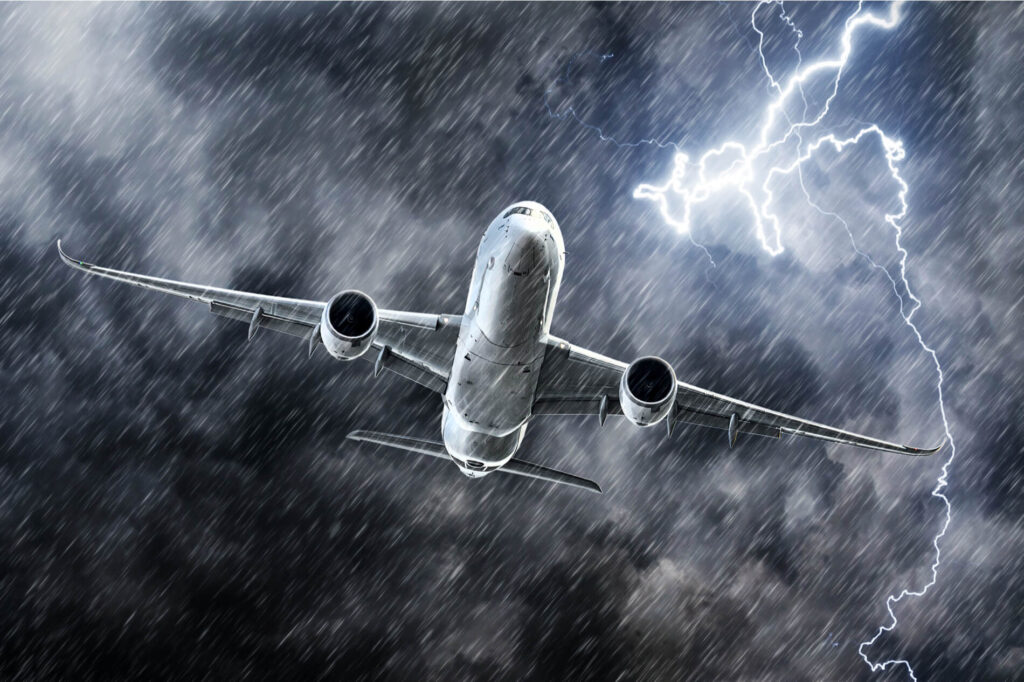Lightning is a sudden high-voltage discharge of electricity that occurs within a cloud, between separate clouds, or between a cloud and the earth’s surface. On average, around 40 to 50 flashes of lightning happen every second around the world. Lightning is powerful and can prove to be deadly, but how dangerous is it to a plane and its passengers?
How often do planes get struck by lightning?
Experts estimate that on average, lightning hits aircraft once per year or once per every 1,000 hours of flight time.
The last incident when a lightning strike ended in a catastrophe occurred in 1963. The lightning caused a crash of a Pan American Boeing 707 in Maryland, the U.S. and 81 passengers died on board. Investigators concluded that lightning-induced ignition of the fuel/air mixture in a fuel tank was at fault. The crew lost control of the plane after the outer left wing disintegrated due to the explosion.
Usually, planes are struck by lightning at an altitude of 5,000 to 15,000 feet (1,524 to 4,572 meters), often following take-off or descent. The presence of rain is another factor that increases the chances of lightning to occur. If lightning strikes a plane after take-off, the aircraft usually returns to the airport it departed from, mostly as a precaution to ensure all systems are working fine as some of them cannot reboot mid-air.
Most lightning strike incidents happen during spring and summer. The probability of a lightning strike generally decreases at higher altitudes of 20,000 feet (6,096 meters) and above.
How severe could a lightning strike be for an aircraft?
Although a lightning strike can be quite an unpleasant experience for the aircraft crew and passengers, in most cases it does not cause much physical damage to the plane, nor does it compromise its safety.
Typically, lightning hits certain parts of an aircraft like a wingtip or the nose. The charge then travels through the airplane’s metal shell before leaving at another point like the tail. The thunder that follows the strike itself can be almost deafening in the cabin, while other times the cabin crew may not hear anything.
The type and intensity of damage to a plane depend on several factors, including the strike’s energy discharge level, the attachment and exit locations, and the strike duration. A single lightning strike can contain around 1 million volts or 30,000 amps.
Lightning can cause minor damage to aerials, compasses, avionics, and leave small puncture holes in the fuselage, radomes, and tail fins. In addition, lightning flash, especially at night, can temporarily blind the flight crew. In more severe cases, the incident can result in engine shutdown on both Full Authority Digital Engine Control (FADEC) and non-FADEC engines with close-spaced engine pairs. In rare cases after a lightning strike, one or more generators can turn off, which would shut off cabin lights until the generator is once again reset.
The prevention measures for the light striking incidents
The lightning strike can affect airline operations and cause costly delays and service interruptions. To avoid such incidents, maintenance personnel must be familiar with lightning protection measures, proper inspection, and repair procedures. Pilots’ standard procedure is to remain at least 20 nautical miles away from any Cumulonimbus (Cb) clouds. In addition, modern aircraft are designed to allow lightning to move along the airplane’s skin without doing damage.
According to the director of Cardiff University’s Morgan-Botti Lightning Laboratory, Professor Mamu Haddad, modern planes are made of lightweight carbon composite covered with a thin layer of copper and act as Faraday Cages. There are metal strips between everything to make sure the electricity gets conducted. As a result, the space inside the metal (the aircraft cabin) is protected from electric currents. While in the air, in case of the lightning strike, airplanes would dissipate the lightning quickly and a static wick will be the main target of lightning exiting the aircraft. The fuel tanks in the wings are not exposed to any lightning sparks because the surrounding metal, structural joints, access doors, vents, and fuel filler caps can withstand any burning from a bolt of lightning, which temperature can reach up to 30,000C. And to make sure that most serious incidents are avoided, planes are tested and certified for lightning strikes and go through rigorous light strike simulations.

